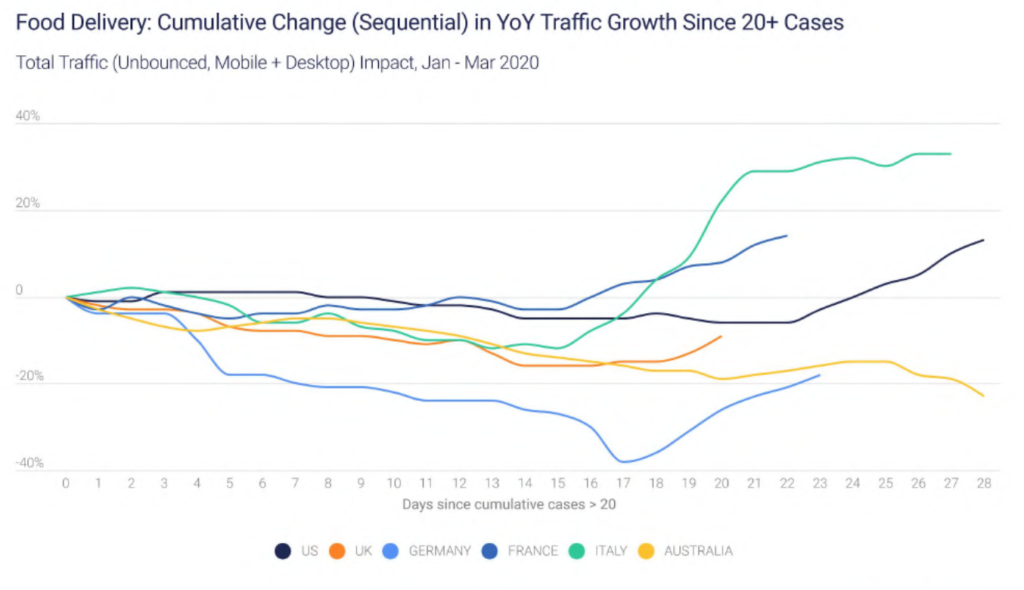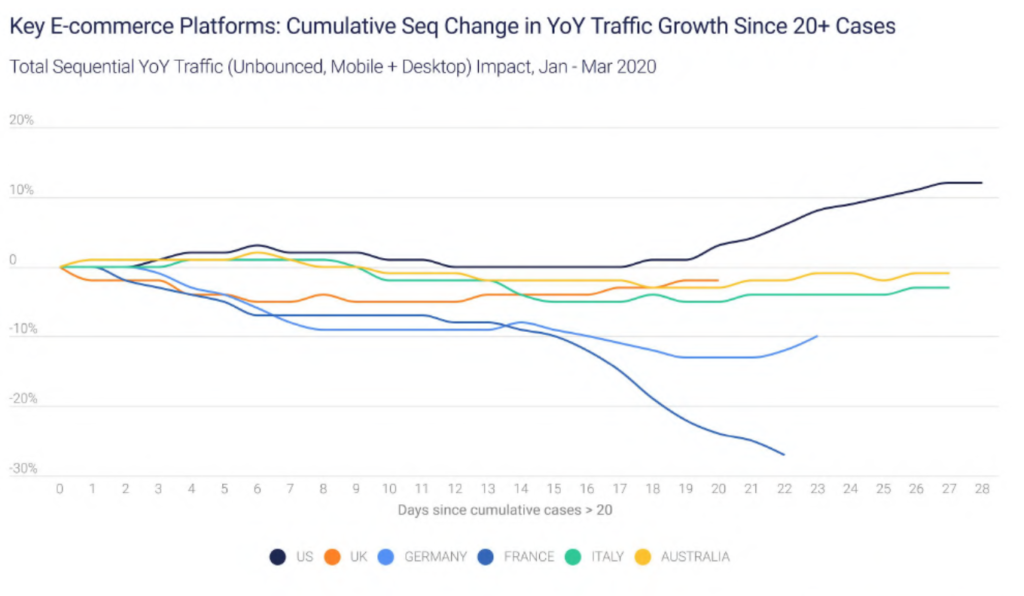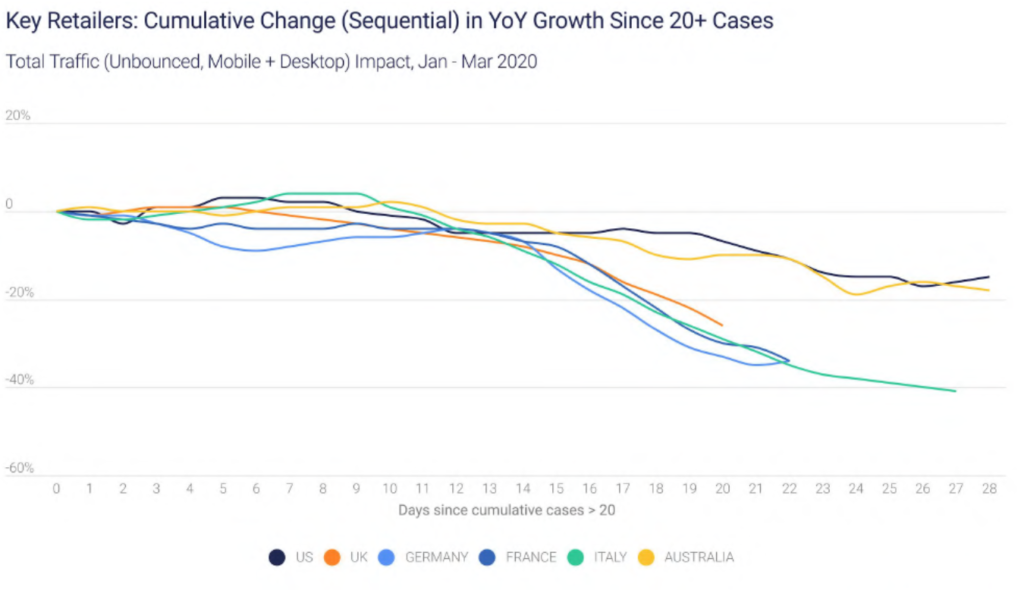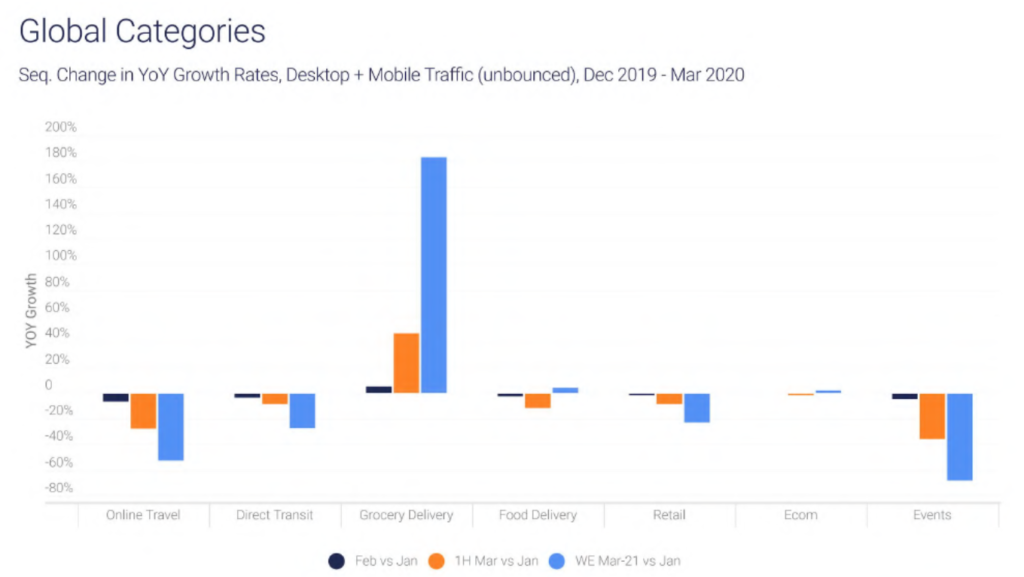Written by: Marek Zmysłowski
Disclaimer: Data here is based mostly on Similar Web data from the period from December 1, 2019, to 26th March 2020, including traffic to Desktop and Mobile web originating from multiple developed countries around the globe. Considering how dynamic the situation with COVID-19 is, and how unpredictable people under lockdown are, if you are reading these couple days later, the situation might be much different. I’ll try to keep updating this piece though.
Last week was extremely important in customer behavioral change since that was the period when most countries entered the economy shut down, full lockdown, and self-quarantine period. The number of countries with more than 100 daily cases has more than doubled, from 14 to 31. In general, e-commerce is getting better. Two weeks ago we saw paranoid toilet paper buying and zombie apocalypse stocking. Last week was more of an “adjustment” period to isolation. This week starts the “backfilling” period. Buyers accept the new reality, and that they will be stuck with their families for a tiny little bit longer.
What we are observing is a black swan event (check out Nassim Taleb’s book with the same title) creating paradigm shifts that reshape consumer patterns for years to come. In many respects, the consumer and business patterns emerging in the immediate aftermath reflect a continuation of the trends we’ve already seen over the last decade, just with 10x the speed, just like Aleksander Poniewierski, Head of Global IoT Ernst & Young, predicted in his latest book. Alright, let’s get down to it:
Web conferencing. Obvious Short (& Mid, &Long?) Term Winner.
Services are being co-opted by businesses and consumers alike, with both weekday and weekend traffic on business-facing platforms up significantly. Web conferencing demonstrates the friction-fighting mechanisms of remote work, a concept that may unlock new methods of productivity for years to come. The surge is unprecedented and global. I expect to see similar in terms of growth, but the slower success of different remote work tools and software. White collars are finally realizing that this meeting really could be an email! Or a project in Asana.

R.I.P. Online Travel. Well, at least for now.

No further comment needed about the reasons. What will be definitely interesting to see is to what levels will the global travel bounce back. 9/11 has definitely changed the way we travel (sending kisses to TSA people). COVID-19 probably saw it and said, “hold my beer”. Probably a Corona beer, poor company, by the way, if you look at this photo. Positive spin though, it was fact-checked, and apparently it’s not that bad.
Grocery delivery. Get ready for the ride, baby.
Traffic continues to accelerate, though delivery backlogs may present a challenge. Grocery delivery problem number one over the last decade was user penetration. A prolonged period of lockdown drives forced user acquisition, billions of dollars wasted on free orders for first-time consumers are suddenly not needed anymore.
However, surges in demand are putting logistics to the test, which could create a choppy growth pattern. Compared to food delivery, grocery delivery is significantly more labor-intensive, and major providers are scrambling to hire (and train) the workers they need to meet the demand.
Real-time inventory management is also a critical task, and the risk of disappointing newly “acquired” users is high. In the UK, major players like Ocado have temporarily pulled their sites in order to adjust to the high demand. In the US, wait times for grocery delivery continue to increase, which provides an opportunity for food delivery to fill the gap.

Event/Ticketing platforms. Tango down.
Probably for longer than Travel, events are less essential than some journeys.

Food delivery. It’s great, but we’re probably screwed anyway.
On one hand, services that cater to an immobilized base of consumers would certainly benefit. On the other hand, it’s hard to imagine that people sitting at homes won’t cook for themselves and only order delivery, especially in the wake of the upcoming recession. They will want to save money. Doing only delivery won’t be enough for most restaurants to stay open. operators are also facing difficult economic and safety decisions by staying open.

E-Commerce. Not many changes really…
Global trends remain flat, despite the clear benefits of an immobilized consumer base. Whatever the benefit is currently accruing to major eCom sites from the hyperactive stocking of the household inventory, it is being largely offset by the same pressures facing the broader online retail category. You’re not gonna buy a new dress if the only person you can show it to is your lazy-ass-coach-potato-beer-and-cookie-monster husband, right?

Big Fat Global Retail.
As a broad measure of consumer health, retail traffic are closing down. Retailers still conduct roughly 80% of their business offline, you could assume that locked clients will drive online traffic. It’s not really happening though, probably for the same reasons as pure e-commerce. People are shifting to high-priority products, considering most households are undergoing a major disruption in lifestyle and routine. It’s probably going to stay this way for a while. Discretionary retail is showing accelerating declines, as wallet share shifts to high priority products. Divergences between retail categories begin to tell a story of who’s impacted the most.

SEQUENTIAL YoY relative to January of this year.
Let’s say January is our index of the pre-COVID era in most countries outside China, then this is what you get. March 1st Half (1H) vs Week Ending (WE) March 21st. Two March numbers are shown for sequential YoY growth. 1H March represents all of March to-date (March 1st -21st), while WE March-21 represents the 7 days ending March-21. The comparison of these two numbers relative to January shows the intra-month trend. If WE number is higher than a 1H number, that means the category is trending up during the month.

Source: Global Coronavirus Impact Report by Similar Web, March 26, 2020
Sign up to my newsletter (link) and get a free ebook “Chasing Black Unicorns. How building the Amazon of Africa put me on Interpol Most Wanted list.”

